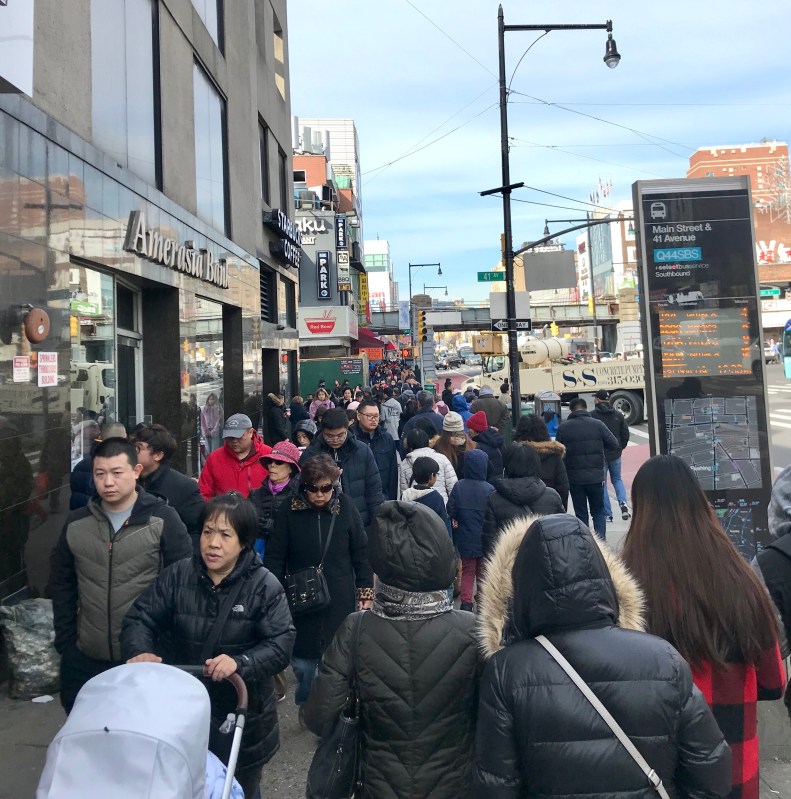Flushing Hopes for its Own ‘Miracle’ on Main Street


It’s time for a miracle on Main Street.
The success of the 14th Street busway has transportation advocates seeking to replicate its success along 34th Street, 42nd Street and Fordham Road — but advocates in Queens want car-free transit on Main Street in Flushing.
“The pedestrian count in downtown Flushing is only second to Times Square,” said John Choe, executive director of the Greater Flushing Chamber of Commerce. “Our commercial district is the largest transportation hub outside of Manhattan, and the city hasn’t taken the needs of the business community very seriously.”
Main Street is an extension of Flushing’s booming downtown where passersby, cars, buses, cyclists and vendors fight for space. Its streets are some of the most congested — and dangerous — in the city.
Flushing’s population rose about 6 percent over the last decade, according to census data. Yet households with vehicles dropped 10 percent within the same period.

In downtown Flushing, nearly 80 percent of shoppers either walk or use public transportation, according to city studies.
For Choe, an ideal Main Street busway would run from Northern Boulevard to Franklin Avenue, a .6-mile stretch where 239 crashes occurred in 2018, injuring six cyclists, 30 pedestrians and eight motorists, with one pedestrian being killed, according to city data published by Crashmapper.
John Kelly IV, a safe-streets activist, relies on Main Street’s packed buses for commuting to work, and witnessed car-induced carnage.
“Reorganizing the streets can help thousands of people every day,” said Kelly.
“I’ve seen multiple crashes on Main Street. It seems like most of the car drivers are confused, possibly since anyone who lives around here knows better than to drive on Main Street. Since the local residents are mainly pedestrians and bus riders, the streets should be designed for pedestrians and bus riders.”
Instead, cars reign, with no bike lanes available to cyclists on Main Street, though downtown Flushing did get unprotected bike lanes over the summer.
Flushing Council Member Peter Koo has been a non-presence on street safety issues. In 2017, at a Flushing Department of Transportation forum, Koo said, “Biking is good for your health, it saves gas, it’s good for the environment, but it’s not appropriate in downtown Flushing.” And he declined Streetsblog’s request for comment for this story — and has been equally silent in the past.
Crashes occur at alarming rates in the downtown corridor — 90 crashes occurred this year in the immediate two-block area centered on Main Street and Roosevelt Avenue, injuring six cyclists and 13 pedestrians, according to Crashmapper.
Downtown Flushing’s streets cannot handle the amount of people trying to use them, thanks to all the cars, said Joby Jacob, an Eastern Queens volunteer with Transportation Alternatives.
“Realistically speaking, we can’t build more roads downtown so we have to be smarter about how we use the roads that we do have. A Main Street busway is an idea whose time has come,” said Jacob.
The DOT did create a mini-busway on southbound Main Street between 37th Avenue and 40th Road as part of a sidewalk extension project — and bus speeds along that very short stretch improved by 23 percent, shaving a full minute off the ride from Northern Boulevard to 40th Road.
For now, the DOT is remaining tight-lipped about more ambitious plans to keep cars from the northbound lanes of Main Street, or extend the existing bus-and-truck-only portion.
“We’re consistently looking for ways to reduce New Yorkers’ reliance on cars and make it easier to get around the city, which is why we’re very happy with initial results of the 14th Street busway,” said Lolita Avila, a DOT spokeswoman. “However, transforming any major street is not a decision the city takes lightly. We plan to make decisions on next steps sometime next year after reviewing more concrete data, including whether to create additional busways.”
A transit hub, Main Street is a drop off point for more than 15 MTA bus lines, the 7 train, a LIRR stop and a network of Chinatown-bound dollar vans. Commuters line the sidewalks, wrapping around Roosevelt Avenue waiting for buses during the busiest hours.
Roughly 200,000 daily bus passengers are shuttled through Main Street, according to DOT data. At Kissena Boulevard and Main Street alone, 10,000 riders board the buses daily, which is more than most subway stops.
“When we get closer to Main Street, buses skip stops, which is terrible for everyone waiting,” said Kelly. “Getting on a bus at Main Street can be a nightmare. In bad weather, there could be three busloads of people waiting at one stop. I’ve seen altercations where someone tries to cut the very long lines.”
Fatrina Williams, a nurse who works in Flushing, rightfully believes a busway can alleviate the heavy delays where downtown buses sit idling behind cars. “There’s a lot of cars, buses and you can’t really get around it, so you’re sitting there for a long time,” said Williams.
Traffic is one of the top three issues in Flushing identified by the local community board, according to a survey by the city Planning Department. It’s why a number of residents refuse to enter the downtown area, said Choe, who is a member of Community Board 7.
“Just going from Main Street-Roosevelt to Northern Boulevard on any of the buses on Main Street takes at least 15 minutes, which is slower than walking three blocks,” said Choe, who has been going door-to-door to get local businesses on board the busway idea.





